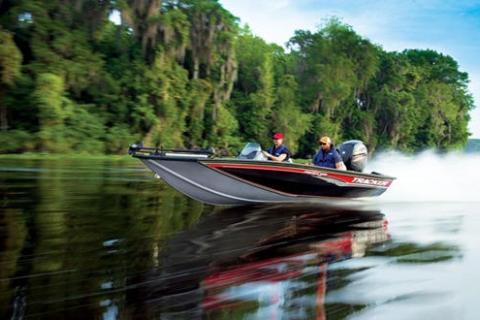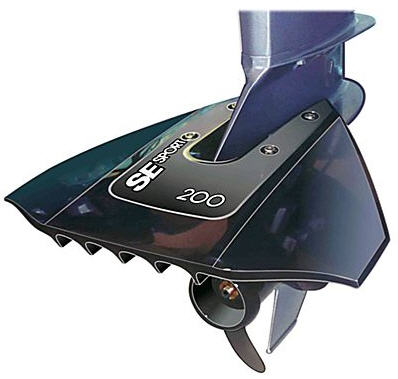
Some boat and motor packages are just not happy combinations. They're slow out of the hole, slow on top end and suck up fuel like there's no tomorrow. They porpoise, they chine walk and they're tough to steer. While there's no universal solution for every combination, one device that helps many problem boats is known generally as the "hydro-foil". These foils or horizontal fins, which clamp or bolt to the cavitation plate of outboard or sterndrive, increase the size and improve the attack angle of this plate as the boat moves through the water.
 |
| illustration by StingRay Hydrofoils |
The idea is to give some added boost at the transom, the area where boats with hole-shot problems frequently "squat"as power is applied. These boats--which typically either have too much weight aft, inadequate power or a propeller pitched too high--can struggle along for hundreds of yards before popping up on top to a full plane. Some never do make it--they plow along bow high, throwing a huge wake. This running attitude not only makes them tricky to steer, it also wastes gas as the boat roars along at maximum drag angle. They're ineffective for towing skiers and wakeboarders due to the slow planing. And when power is cut, there's usually a stern wave churning along close behind that may roll right over the transom.
 |
| SE Sport High Performance Hydrofoil for Boat Motors |
The planing plates, available in either clamp-on models like the Stingray Starfire Hydrofil Stabilizers for boat motors which require no drilling of the cavitation plate or bolt-on models like the SE Sport High Prformance Hydrofoil or the Doel-fin Hydrofoil Stabilizer, both of which require four holes drilled via template, add planing surface aft as well as apparently preventing prop "blow-out". Some users also report reduced exhaust noise when the boat is on plane.
But the big advantage is in the boost at take-off. A well-set-up boat in the runabout or bass boat category should get on top in 4 to 5 seconds, and the foils make that possible in many cases with packages that previously took 8 to 10 seconds to get up, if they ever made it.
Another plus for the foils comes when slowing down, for example, to soften the ride in choppy seas; they make it possible to stay on plane at lower speed, thus greatly improving the ride.
And of course the fuel economy is maximized when running on plane versus plowing along at 2500 to 3000 rpms just off plane. Most planing rigs get their best economy when fully trimmed up and running at 3500 to 4500 rpms, and the foils make this possible on some combo's that just can't make it without some help.
Anglers who fish the saltwater flats, where near instant planing is often called for to jump up in a shallow area, can also benefit from the hydrofoils. They're not necessary on a well set-up boat with the right power and prop, but on rigs where the combination of loading, power and prop are challenged, they can provide an affordable improvement in performance.
Boating Safety Tips:
- If your boat is fitted with a kill cord, make sure you wear it at all times.
- Wear your kill switch.
- Wear eye protection. This will reduce wind from hitting your eyes and allowing you to see better.
- Before and at speed ensure that everyone has a good seating position and a firm grip.
- Avoid making rapid changes in direction. Should you find yourself in a potential collision situation, take early action by carefully turning away from the on-coming boat. Before making a turn, check all aroudn the boat, including behind you, to avoid collisions with other boaters. Or, if you've got some distance between you and the other boat, turn the power down to reduce your closing speed and reassess the situation.
- Keep a good look out for other boats, watch for waves and predict the effect of waves or the wash from other boats.
- Most importantly, adjust the speed to suit the conditions, traffic and environment in which you are operating your boat.
![]() Tip: Check out more safe boating tips at Discover Boating
Tip: Check out more safe boating tips at Discover Boating
- 55798 views

